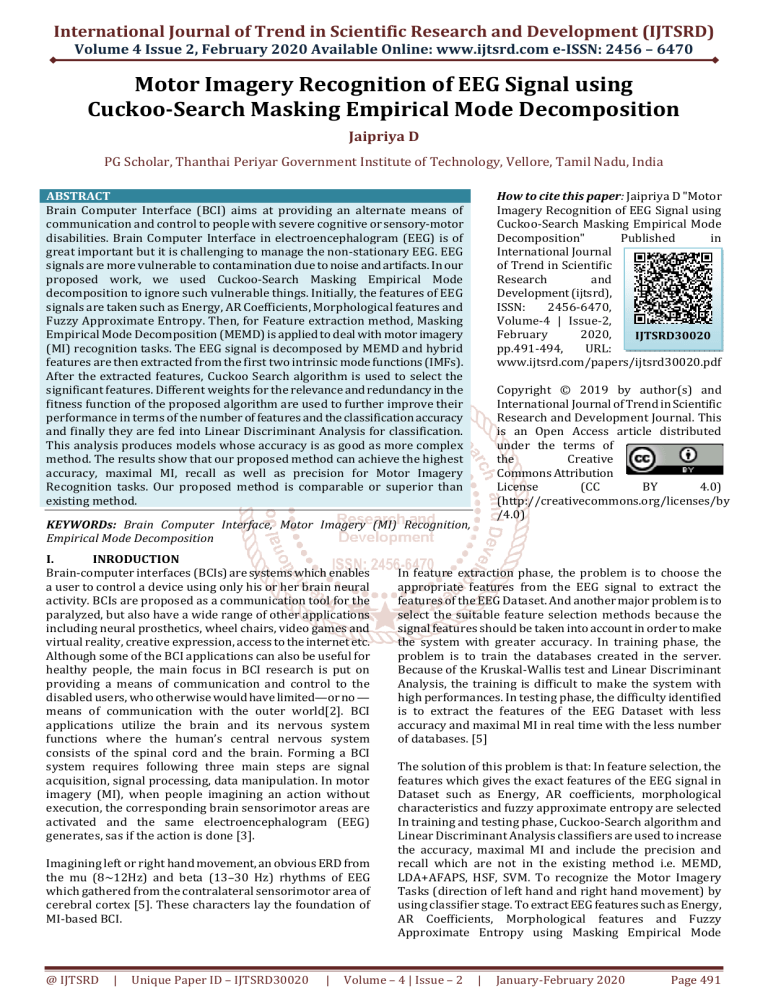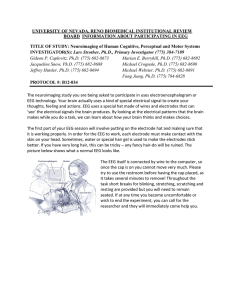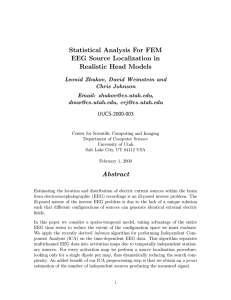
International Journal of Trend in Scientific Research and Development (IJTSRD)
Volume 4 Issue 2, February 2020 Available Online: www.ijtsrd.com e-ISSN: 2456 – 6470
Motor Imagery Recognition of EEG Signal using
Cuckoo-Search Masking Empirical Mode Decomposition
Jaipriya D
PG Scholar, Thanthai Periyar Government Institute of Technology, Vellore, Tamil Nadu, India
How to cite this paper: Jaipriya D "Motor
Imagery Recognition of EEG Signal using
Cuckoo-Search Masking Empirical Mode
Decomposition"
Published
in
International Journal
of Trend in Scientific
Research
and
Development (ijtsrd),
ISSN:
2456-6470,
Volume-4 | Issue-2,
February
2020,
IJTSRD30020
pp.491-494,
URL:
www.ijtsrd.com/papers/ijtsrd30020.pdf
ABSTRACT
Brain Computer Interface (BCI) aims at providing an alternate means of
communication and control to people with severe cognitive or sensory-motor
disabilities. Brain Computer Interface in electroencephalogram (EEG) is of
great important but it is challenging to manage the non-stationary EEG. EEG
signals are more vulnerable to contamination due to noise and artifacts. In our
proposed work, we used Cuckoo-Search Masking Empirical Mode
decomposition to ignore such vulnerable things. Initially, the features of EEG
signals are taken such as Energy, AR Coefficients, Morphological features and
Fuzzy Approximate Entropy. Then, for Feature extraction method, Masking
Empirical Mode Decomposition (MEMD) is applied to deal with motor imagery
(MI) recognition tasks. The EEG signal is decomposed by MEMD and hybrid
features are then extracted from the first two intrinsic mode functions (IMFs).
After the extracted features, Cuckoo Search algorithm is used to select the
significant features. Different weights for the relevance and redundancy in the
fitness function of the proposed algorithm are used to further improve their
performance in terms of the number of features and the classification accuracy
and finally they are fed into Linear Discriminant Analysis for classification.
This analysis produces models whose accuracy is as good as more complex
method. The results show that our proposed method can achieve the highest
accuracy, maximal MI, recall as well as precision for Motor Imagery
Recognition tasks. Our proposed method is comparable or superior than
existing method.
Copyright © 2019 by author(s) and
International Journal of Trend in Scientific
Research and Development Journal. This
is an Open Access article distributed
under the terms of
the
Creative
Commons Attribution
License
(CC
BY
4.0)
(http://creativecommons.org/licenses/by
/4.0)
KEYWORDs: Brain Computer Interface, Motor Imagery (MI) Recognition,
Empirical Mode Decomposition
I.
INRODUCTION
Brain-computer interfaces (BCIs) are systems which enables
a user to control a device using only his or her brain neural
activity. BCIs are proposed as a communication tool for the
paralyzed, but also have a wide range of other applications
including neural prosthetics, wheel chairs, video games and
virtual reality, creative expression, access to the internet etc.
Although some of the BCI applications can also be useful for
healthy people, the main focus in BCI research is put on
providing a means of communication and control to the
disabled users, who otherwise would have limited—or no —
means of communication with the outer world[2]. BCI
applications utilize the brain and its nervous system
functions where the human’s central nervous system
consists of the spinal cord and the brain. Forming a BCI
system requires following three main steps are signal
acquisition, signal processing, data manipulation. In motor
imagery (MI), when people imagining an action without
execution, the corresponding brain sensorimotor areas are
activated and the same electroencephalogram (EEG)
generates, sas if the action is done [3].
Imagining left or right hand movement, an obvious ERD from
the mu (8~12Hz) and beta (13–30 Hz) rhythms of EEG
which gathered from the contralateral sensorimotor area of
cerebral cortex [5]. These characters lay the foundation of
MI-based BCI.
@ IJTSRD
|
Unique Paper ID – IJTSRD30020
|
In feature extraction phase, the problem is to choose the
appropriate features from the EEG signal to extract the
features of the EEG Dataset. And another major problem is to
select the suitable feature selection methods because the
signal features should be taken into account in order to make
the system with greater accuracy. In training phase, the
problem is to train the databases created in the server.
Because of the Kruskal-Wallis test and Linear Discriminant
Analysis, the training is difficult to make the system with
high performances. In testing phase, the difficulty identified
is to extract the features of the EEG Dataset with less
accuracy and maximal MI in real time with the less number
of databases. [5]
The solution of this problem is that: In feature selection, the
features which gives the exact features of the EEG signal in
Dataset such as Energy, AR coefficients, morphological
characteristics and fuzzy approximate entropy are selected
In training and testing phase, Cuckoo-Search algorithm and
Linear Discriminant Analysis classifiers are used to increase
the accuracy, maximal MI and include the precision and
recall which are not in the existing method i.e. MEMD,
LDA+AFAPS, HSF, SVM. To recognize the Motor Imagery
Tasks (direction of left hand and right hand movement) by
using classifier stage. To extract EEG features such as Energy,
AR Coefficients, Morphological features and Fuzzy
Approximate Entropy using Masking Empirical Mode
Volume – 4 | Issue – 2
|
January-February 2020
Page 491
International Journal of Trend in Scientific Research and Development (IJTSRD) @ www.ijtsrd.com eISSN: 2456-6470
Decomposition, and to select the particular features using
Cuckoo-Search Algorithm to EEG data of performing motor
imagery on another day.
The remainder of this paper is organized as follows: Section
II describes the experimental methodology for this study.
Section III presents the experimental results. Finally, section
IV concludes the paper.
C. Least mean square algorithm:
LMS algorithm is relatively simple; it does not require
correlation function calculation. LMS algorithms are a class
of adaptive filter used for adaptive noise cancellation by
varying its step size parameter µ for different filter order and
number of iteration. It is a stochastic gradient descent
method in that the filter is only adapted based on the error at
the current time.
II.
SUBJECTS AND METHODS
A. Subjects
This study recruited 12 healthy subjects. Ethics approval and
informed consent were obtained. Two subjects chose to
perform motor imagery and passive movement of the left
hand while the remaining 10 subjects chose to perform on
the right hand.
B. EEG data collection
The recording was made using Brain Amp MR plus
amplifiers and an Ag/AgCl electrode cap. Signals from 59
EEG positions were measured that were most densely
distributed over sensorimotor areas. Signals were band-pass
filtered between 0.05 and 200 Hz and then digitized at 1000
Hz with 16 bit (0.1 µV) accuracy. We provide also a version
of the data that is down sampled at 100 Hz (first low-pass
filtering the original data (Chebyshev Type II filter of order
10 with stop band ripple 50dB down and stop band edge
frequency 49Hz) and then calculating the mean of blocks of
10 samples). Here, the motor imagery tasks were cued by
soft acoustic stimuli (words left, right, and foot) for periods
of varying length between 1.5 and 8 seconds. The end of the
motor imagery period was indicated by the word stop.
Intermitting periods had also a varying duration of 1.5 to 8s.
Note that in the evaluation data, there are not necessarily
equally many trials from each condition.
Fig.2 LMS Methodology
1. Masking Empirical Mode Decomposition:
Empirical mode decomposition (EMD) is one such adaptive
signal processing technique for decomposing a signal. The
signal decomposition aims at revealing intrinsic mode
functions (IMFs) having meaningful instantaneous
frequency.
A masking signal of frequency higher than the highest
frequency component present in the original non-stationary
signal is added and subtracted to obtain two new signals.
EMD is performed on these two signals to extract the first
IMFs from these two signals. The average of these two is
computed to yield IMF of the original signal. The main idea of
this method is to insert a row of sine wave s (t) (masking
signal) into the original signal to prevent the mode mixing
phenomenon which is caused by the low frequency
components mixing into the IMF in the process of the EMD.
2. Cuckoo-Search Algorithm
Cuckoo Search (CS) is heuristic search algorithm which is
inspired by the reproduction strategy of cuckoos. Cuckoo
bird or something like water drops but also provides some
principles which can help in providing solutions to real
world applications .These algorithms work on the basis of
random search in some suitable search region depending on
the problem.
Fig.1. Experimental setup to collect EEG data from
passive movement of the left hand
There are four spectral features extracted such as Energy, AR
coefficients, Morphological features and Fuzzy approximate
entropy in the proposed classification
Energy
Energy is a crucial parameter for the identification of leftright MI EEG. The expression is given by,
Where N is the length of the signal.
AR coefficients, Morphological features
approximate entropy are also extracted.
@ IJTSRD
|
and Fuzzy
Unique Paper ID – IJTSRD30020
|
CSA is one of the modern nature inspired meta-heuristic
algorithms. CS algorithm is based on the obligate brood
parasitic behavior of some cuckoo species in combination
with the Levy flight behavior of some birds and fruit flies.
3. Linear Discriminant Analysis
(LDA) is aclassification method based upon the concept of
searching for a linear combination of variables (predictors)
that best separate two best separate two classes.. LDA works
when the measurements made on each observation are
continuous quantities. The objective of LDA is to perform
dimensionality reduction while preserving as much of the
class Discriminatory information as possible.
Technique for CSMEMD is proposed in this paper, Motor
Precision Imagery Recognition of EEG signal using Cuckoo
Search Masking Empirical Mode Decomposition has various
stages to get the classified output. Different stages are LMS,
Volume – 4 | Issue – 2
|
January-February 2020
Page 492
International Journal of Trend in Scientific Research and Development (IJTSRD) @ www.ijtsrd.com eISSN: 2456-6470
MEMD, CS-Algorithm and LDA. And also the output of the
proposed method is compared to LDA+AFAPS, HSF, MEMD,
SVM.
Recall
III.
EXPERIMENTAL RESULTS
Visual studio coding to evaluate performance of MEMD and
CSMEMD by calculated the basic parameters like Accuracy,
Precision, Recall, MaximalMI. The performance Evolution of
the proposed Algorithm shows the analysis of accuracy,
precision, recall and maximal MI for Number of Training
data sets.
Accuracy
The accuracy of a measurement system is how close it gets
to a quantity’s actual (true) value. It increases the
performance of the system.
Fig.5 Recall Vs No. of training data
Maximal MI
Fig3 Accuracy Vs No of Training Data
The performance evolution of the proposed algorithm shows
the analysis of accuracy for number of training
datasets.When the Number of Training data set is seven, the
accuracy is attained for LDA+AFAPS be 90.6%, HSF will be
88.5%,MEMD will be 89.7% and our proposed Algorithm will
achieve a accuracy of 92% which is maximum than other
three methods. As the Number of training Data set is
increased, there is a gradual increase, decrease in accuracy.
But our proposed algorithm (CSMEMD) maintains a slow
increase in accuracy as the number of training set is
increased. This means our proposed method gives a better
accuracy as the number of training data set is increasing.
Fig 5 Maximal MI Vs No of Training Data
The performance evolution of the proposed algorithm for
Precision, Recall and Maximal MI shown in Fig3,Fig 4, Fig5.
Accuracy, Precision, Recall and Maximal MI for CSMEMD,
Precision, Recall and Maximal MI for CSMEMD is more when
compared with LDA+AFAPS, HSF, MEMD, SVM. In CSMEMD
the four parameters were increased.
Precision
IV.
CONCLUSIONS
Finally the objective mentioned has been achieved
successfully. The experiment was conducted by using seven
EEG datasets from BCI competition. To analyze the
performance of LDA+AFAPS, HSF, MEMD, SVM and CSMEMD
the feature vectors namely energy, AR coefficients,
morphological features and fuzzy approximate entropy were
extracted from the motor imagery EEG dataset to measure
the performance metrics like Accuracy, Recall, Precision and
Maximal MI. From the analysis the accuracy of the CSMEMD
is higher when compared to other classifiers. Similarly the
precision and recall metrics also gives the higher
performance compare to others. To show the great accuracy
Fig4 Precision Vs No of Training Data
@ IJTSRD
|
Unique Paper ID – IJTSRD30020
|
Volume – 4 | Issue – 2
|
January-February 2020
Page 493
International Journal of Trend in Scientific Research and Development (IJTSRD) @ www.ijtsrd.com eISSN: 2456-6470
and precision of our proposed methodology, we compared
the performance results obtained in this work with results
obtained in other works. Our proposed methodology is an
efficient to recognize the motor imagery tasks.
After the recognition of motor imagery tasks, the obtained
result is given to the specific application, which is considered
to be our future work.
REFERENCES
[1] Jonathan R. Wolpawab,*, Niels Birbaumerc,d, Dennis J.
Mc Farlanda, Gert Pfurtschellere, Theresa M. Vaughana
‘Brain–computer interfaces for communication and
control’ proceeding of Clinical Neurophysiology 113
(2002) 767–791.
[2] Rabie A. Ramadan, S.Refat, Marwa A. Elshahed and
Rasha A. Ali ‘Basics of Brain Computer Interface’
Springer International Publishing Switzerland 2015
[3] Piotr Szachewicz Supervisor Wojciech Jaskowski, PhD
‘classification of motor imagery for brain-computer
interfaces’
[4] Bernhard Graimann, Brendan Allison, and Gert
Pfurtscheller ‘Brain – Computer Interfaces: A Gentle
Introduction’ Springer- Verlag Berlin Heidelberg 2010
[5] Wanzhong Chen*,Yang You ‘Masking Empirical Mode
Decomposition-Based Hybrid Features for Recognition
of Motor Imagery in EEG’, proceeding of third IEEE
International Conference on Control Science and
Systems Engineering, 2017
[6] Parthana Sarma1, Prakash Tripathi2, Manash Pratim
Sarma3, Kandarpa Kumar Sarma ‘Pre-processing and
Feature Extraction Techniques for EEG BCI
Applications-A Review of Recent Research’, proceeding
of ADBU-Journal of Engineering Technology , ISSN:
2348 -7305, Volume5(2016).
[7] M. Rajya Lakshmi* Dr. T. V. Prasad Dr. V. Chandra
Prakash, ‘International Journal of Advanced Research
in Computer Science and Software Engineering Survey
on EEG Signal Processing Methods’, Volume 4, Issue 1,
January 2014.
[8] N. Sruthi Sudha, Rama Kotireddy Dodda, ‘Design of
Error Normalized LMS Adaptive filter for EEG signal
with Eye Blink & PLI Artefacts’, proceeding of
International Conference on Trends in Electronics and
Informatics ICEI 2017
[9] Shekh Md Mahmudul Islam1, Md. Salah Uddin Farid2,
‘Denoising EEG Signal using Different Adaptive Filter
Algorithms’, proceeding of International Journal of
Enhanced Research in Science, Technology &
Engineering Vol. 4 Issue 11, November-2015
[10] Cheolsoo Park, David Looney, Naveed ur Rehman,
Alireza Ahrabian, and Danilo P. Mandic , ‘classification
of Motor Imagery BCI Using Multivariate Empirical
Mode Decomposition’, proceeding of IEEE transactions
on neural systems and rehabilitation engineering, vol.
21 , no. 1, January 2013 .
@ IJTSRD
|
Unique Paper ID – IJTSRD30020
|
[11] Sheng Ge, Member, IEEE, Yan-hua Shi, Rui-min Wang,
Pan Lin, Member,IEEE, Jun-feng Gao, Gao-peng Sun,
Keiji Iramina, Member, IEEE, Yuan-kui Yang, Yue Leng,
Hai-xian Wang, Member, IEEE, and Wen-ming Zheng,
Member, ‘Sinusoidal Signal Assisted Multivariate
Empirical Mode Decomposition for Brain-Computer
Interfaces’ proceeding of IEEE journal of biomedical
and health informatics
[12] Asmat Zahra a, Nadia Kanwal a*, Naveed ur Rehman b
,Shoaib Ehsan c, Klaus D. McDonald-Maier c, ‘Seizure
detection from EEG signals using Multivariate
Empirical Mode Decomposition’ proceeding of
Computers in Biology and Medicine 2017
[13] B. S. Raghavendra D. Narayana Dutt, ‘Correction of
Ocular Artifacts in EEG Recordings using Empirical
Mode Decompositio’
[14] Jin Zhang, Jianhao Wei, Xiaofei Liu, Chengqian Wu and
Ying Wang ‘A Novel Application of Empirical Mode
Decomposition (EMD) to Feature Extraction of
Epileptic EEG’
[15] Mahmood Moghadasian, and Seyedeh Parvaneh
Hossein, ’Binary Cuckoo Optimization Algorithm for
Feature Selection in High-Dimensional Datasets’,
proceeding of International conference on Innovative
Engineering Technologies (ICIET’2014.
[16] Hongqing ZHENG, Yangquan ZHOUA, ‘Novel Cuckoo
Search Optimization Algorithm Base on Gauss
Distribution’, proceeding of Journal of Computational
Information Systems.
[17] M. N. Sudha1, S. Selvarajan2*, ‘Feature Selection Based
on Enhanced Cuckoo Search for Breast Cancer
Classification in Mammogram Image’,2016.
[18] Roxana Aldea, Monica Fira , ‘Classifications of Motor
Imagery Tasks in Brain Computer Interface Using
Linear Discriminant Analysis’ proceeding of
International Journal of Advanced Research in Artificial
Intelligence, Vol. 3, No.7, 2014
[19] Jaime F.Delgado Saa, Miguel Sotaquirá Gutierrez ,’EEG
Signal Classification Using Power Spectral Features and
linear Discriminant Analysis: A Brain Computer
Interface Application’, proceeding of eighth LACCEI
Latin American and Caribbean Conference for
Engineering and Technology Muller-Gerking, G.
Pfurtscheller, and H. Flyvbjerg, "Designing optimal
spatial filters for single-trial EEG classification in a
movement task," Clin. Neurophysiol., vol. 110, no. 5, pp.
787-798, May 1999.
[20] Haihong Zhang*, Cuntai Guan, Kai Keng Ang, Chuanchu
Wang and Zheng Yang Chin,’ BCI competition IV – data
set I: learning discriminative patterns for self-paced
EEG- based motor imagery detection’, proceeding of
IEEE 63 transactions on neural systems and
rehabilitation engineering, vol. 11, no. 2, June 2003
Volume – 4 | Issue – 2
|
January-February 2020
Page 494



